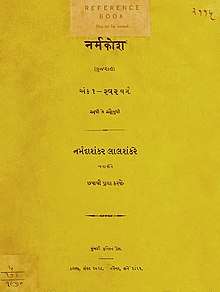Narmakosh
Narmakosh (pronounced [nər.mə.koʃ]), published in 1873, is a monolingual Gujarati dictionary prepared by Narmadashankar Dave (1833–1886), a poet and scholar. Regarded as the first of its kind in the Gujarati language, it contains 25,268 words.
 Title page of first volume, 1861 | |
| Author | Narmadashankar Dave |
|---|---|
| Original title | નર્મકોશ |
| Country | India |
| Language | Gujarati |
Publication date |
|
| OCLC | 40551020 |
| LC Class | PK1847 .N37 1998 |
History
― Narmad, Mari Hakikat, p. 58[1]
Narmad's poems were prescribed for studies in schools. Because he had introduced a new style of writing, students were finding it difficult to understand the meaning of many words of Sanskrit origin that he used in his poems. Complaints reached him and he decided to compile all of the difficult words he had used in his poems and of give their meanings, to enable students to fully comprehend them. Later he decided to expand this into a dictionary covering all the words in the Gujarati language which would be useful to students.[2] Narmad worked for nine years, 1860 to 1868, to prepare it.[3]
The first volume of the dictionary was published in 1861, the second in 1862, the third in 1864 and the fourth and last volume, though prepared in 1866, was published in 1873.[4] In 1873 edition, Narmad discussed in detail the rules of writing in the Gujarati language.[5] He also published his most famous poem, "Jai Jai Garvi Gujarat", for the first time, in the preface of the book.[6][7] Before Narmad, several attempts had been made in Gujarat to compile dictionaries, but all employed both English and Gujarati in their definitions. Narmakosh was the first dictionary to explain the meaning of Gujarati words solely in Gujarati.[4] It contains 25,268 words.[8]
Reception
K. M. Jhaveri considered it one of Narmad's best works, and said that "It has remained a model dictionary ever since it was published in 1873".[9]
References
- Suhrud, Tridip. "Narmadashankar Lalshankar: Towards History and Self Knowing" (PDF). Narrations of a Nation: Explorations Through Intellectual Biographies (Ph.D). Ahmedabad: School of Social Sciences, Gujarat University. p. 53. hdl:10603/46631.
- Broker, Gulabdas (1977). Narmadashankar. New Delhi: Sahitya Akademi. pp. 40–41. OCLC 4136864.
- Jhaveri, Mansukhlal Maganlal (1978). History of Gujarati Literature. New Delhi: Sahitya Akademi. OCLC 5309868.
- Amaresh Datta (1988). Encyclopaedia of Indian Literature: Devraj to Jyoti. New Delhi: Sahitya Akademi. p. 1021. ISBN 978-81-260-1194-0.
- Sebastian, V (August 2009). "Gandhi and the Standardisation of Gujarati". Economic and Political Weekly. 44 (31): 97. JSTOR 25663396. (subscription required)
- Mehta, Nalin; Mehta, Mona G. (2013). Gujarat Beyond Gandhi: Identity, Society and Conflict. Taylor & Francis. p. 17. ISBN 978-1-317-98834-2.
- Yagnik, Achyut (2005). Shaping Of Modern Gujarat. Penguin Books Limited. p. 96. ISBN 978-81-8475-185-7.
- Bal Govind Misra (1980). Lexicography in India: proceedings of the First National Conference on Dictionary Making in Indian Languages, Mysere [i.e. Mysore], 1970. Mysore: Central Institute of Indian Languages. p. 23.
- Krishnalal Mohanlal Jhaveri (1924). Further milestones in Gujarāti literature. Bombay: N.M. Tripathi & Co. p. 71. OCLC 569209571.